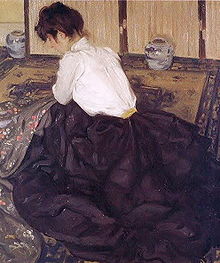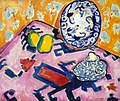Alfred Henry Mason
Alfred Henry Maurer (born April 21, 1868 in New York ; † August 4, 1932 there ) was an American painter . He is considered one of the first artists of American modernism . His extensive and varied work ranges from painterly realism , through a Fauvist and Cubist phase under clear European influence, to an independent visual language.
Life
His parents were the German-born lithographer Louis Maurer and his wife Louisa Stein .
At the age of 16 he finished school to study at the renowned New York art print company Currier and Ives , where his father was also employed. After studying at the National Academy of Design , with the sculptor John Quincy Adams Ward and the painter William Merritt Chase , Maurer went to Paris in 1897, where he would spend the next four years. He joined the American and French artists. At first, Maurer oriented himself towards traditional academic painting, studied at the Louvre and, like many American contemporaries, was mainly influenced by James McNeill Whistler . Maurer's best-known work, An Arrangement from 1901, is said to have been created on a piece of cardboard within a few hours. The composition of the painting is based on Whistler, the decorative picture elements are influenced by the then current Japonism . The painting won first prize at the Carnegie International Exhibition of the Carnegie Museum of Art in Pittsburgh that same year .
Back in New York for a short time in 1909, Maurer exhibited his Fauvist landscape paintings together with the watercolor painter John Marin in the avant-garde gallery 291 by Alfred Stieglitz . In 1913 he took part in the epoch-making Armory Show , where four of his paintings were shown. Maurer was known to numerous well-known American modernists such as Arthur Garfield Dove , Marsden Hartley or John Marin, who all belonged to the circle around Stieglitz ("Alfred Stieglitz Circle"). From 1916 he took part in numerous exhibitions of the Anderson Galleries and the Society of Independent Artists and was elected chairman in 1919. In the 1920s, Maurer pursued a cubist imagery. His portraits of women from the period, Portrait of a Girl (1923), Two Sisters (approx. 1924) or Two Woman (approx. 1926) are stylistically reminiscent of Amedeo Modigliani .
The influences of the European avant-garde are already clearly visible in Maurer's early work: in Paris he continuously changed styles from 1906 and painted in realistic, impressionistic, cubist and fauvist manner, risking his international reputation. At times he received Paul Cézanne's still lifes, which marked the transition from post-impressionism to cubism . With the outbreak of the First World War , Maurer went back to New York for good, where he retired to his father's house. There he painted for the next 17 years in the attic, which had been converted into a studio, and in the long term withdrew from the public. Finally - isolated from any new artistic tendencies - he developed his own, predominantly monochrome, cubist visual language in his later work, which, however, despite his reputation as an "avant-garde" artist, received less attention. To make matters worse for Maurer, the work of his father, with whom he was in a kind of “artistic competition” and whose recognition he strove for life, was rediscovered and at times attracted more attention in exhibitions.
Just a few weeks after his father's death, in 1932, Maurer hanged himself. After his death, parts of his work were incorporated into the collections of the Memorial Hall Museum in Philadelphia , the Phillips Memorial Gallery in Washington, DC , the Barnes Collection in Merion , Pennsylvania, and the Whitney Museum of American Art in New York. As early as 1924, the art dealer Erhard Weyhe had acquired the entire stock from Maurer's studio and represented the artist until his death. Much of Maurer's work is privately owned.
Works
literature
- Daphne Anderson Deeds: Alfred Maurer: The First American Modern , University of Minnesota Press, 2003, ISBN 0-8166-4382-2
Web links
- Alfred Henry Maurer at artfacts.net
- Hollis Taggart Galleries: Alfred Henry Maurer - Biography (English).
- Alfred H. Maurer: American Modernist (Engl.)
Individual evidence
- ^ A b Alfred H. Maurer: American Modernist. In: Sheldon Memorial Art Gallery and Sculpture Garden, University of Nebraska. Retrieved July 25, 2008 .
- ^ Asian Influence. (No longer available online.) In: American Attitude: Whistler and His Followers. The Detroit Institute of Arts, archived from the original on June 7, 2009 ; Retrieved July 25, 2008 .
| personal data | |
|---|---|
| SURNAME | Mason, Alfred Henry |
| BRIEF DESCRIPTION | American painter |
| DATE OF BIRTH | April 21, 1868 |
| PLACE OF BIRTH | New York City |
| DATE OF DEATH | 4th August 1932 |
| Place of death | New York City |




